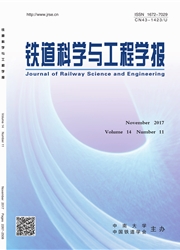

 中文摘要:
中文摘要:
建立了连续刚架拱桥边跨钢拱肋与预应力混凝土系梁连接部位三维有限元空间模型,模拟了该部位在各种荷载工况下的受力情况。计算模型考虑了普通钢筋与预应力钢筋的不同力学性能,分别用配筋率和带初应变的杆单元模拟,并依据圣维南原理设置了荷载加载段以消除边界效应。根据计算结果,分析了边拱与刚性系梁连接区域的变形情况和应力状态,并设计了相似比为1:3.2的模型进行加载试验,测试了关键部位的应变和变形,与有限元计算结果进行了对比分析,检验了设计的安全性与合理性。分析和试验表明,过渡段的支座上方与拱肋上下弦管交汇处为主要的应力集中部位,应在设计中予以注意。
 英文摘要:
英文摘要:
Three- dimensional finite element model of connection part between side arch and rigid tied- girders was built for continuous rigid frame arch bridge, and the mechanical behaviors of this part under various loading conditions were simulated. The differences of mechanical behavior between common steel bar and prestressed tendon were considered in modeling, and they were simulated by rebar rates and link elements, respectively. Segments for adding loads were set up on basis of Saint - Venant Theory to avoid boundary effect. According to calculation results, the deformation and stress states of connection part were analysed, and model test of similitude ratio 1 : 3.2 was done for observing stain and deformation of crucial parts, which were compared with finite element calculation results, and the safety and rationality of design was verified. The calculation and experimentation results indicate that the upside of bearing and the intersectant part of up chord and bottom chord are stress concentration parts, to which importance should be attached in design.
 同期刊论文项目
同期刊论文项目
 同项目期刊论文
同项目期刊论文
 期刊信息
期刊信息
